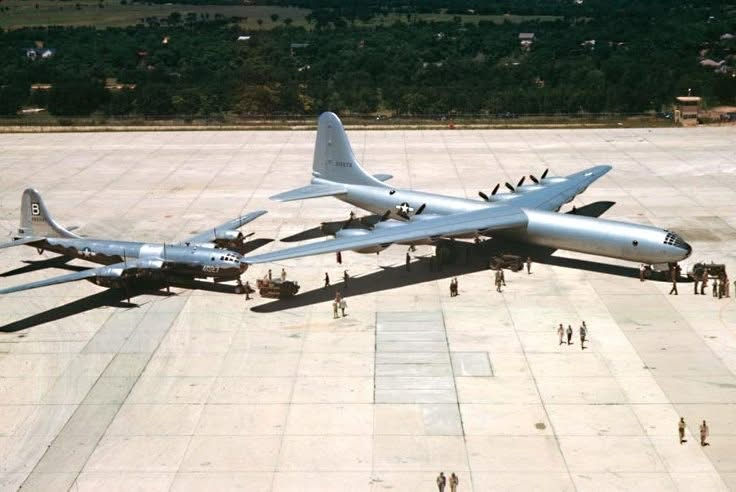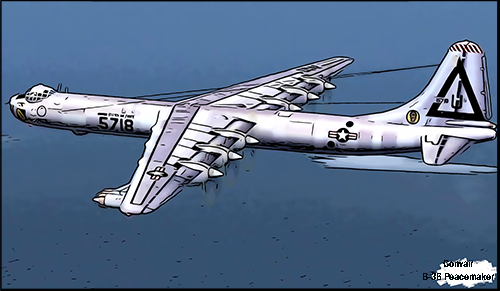top of page



B-36
Peacemaker



1/2




Total Shot Down
info

Variant |
|---|
B-36A |
B-36 |
B-36D |
B-36J |
Initial production variant with limited operational capabilities.
The Convair B-36 Peacemaker was a strategic bomber developed by the United States in the late stages of World War II and introduced during the early Cold War. Designed to meet the U.S. Army Air Forces' requirement for a bomber capable of delivering nuclear payloads across intercontinental distances without refueling, the B-36 was a technological marvel and the largest piston-engine aircraft ever mass-produced. With its immense range, bomb load capacity, and versatility, the B-36 symbolized American airpower in the early Cold War and was a critical Strategic Air Command (SAC) component.
Design and Features
The B-36 was notable for its massive size, featuring a wingspan of 230 feet and a length of 162 feet, making it one of the largest military aircraft ever built. Its powerplant configuration included six Pratt & Whitney R-4360 Wasp Major piston engines in a pusher arrangement, complemented by four General Electric J47 turbojet engines added in later variants for additional thrust during takeoff and high-speed operations, earning it the nickname "six turning, four burning."
Key features of the B-36 included:
Payload Capacity: Capable of carrying up to 86,000 pounds of bombs, including nuclear weapons.
Range: An operational range exceeding 10,000 miles without refueling, enabling it to strike targets across continents.
Defensive Armament: Equipped with up to 16 remote-controlled 20 mm cannons for defense, these were gradually removed in later variants to reduce weight and improve performance.
Pressurized Crew Compartments: The crew could operate comfortably during long missions at high altitudes.
Variants
The B-36 underwent significant development during its production, resulting in several variants tailored for specific missions:
B-36A: The initial production model is used primarily for training and evaluation. It lacked armament and operational bomb bays.
B-36B: The first fully operational variant, equipped with defensive armament capable of carrying conventional and nuclear payloads.
B-36D: Introduced the addition of four turbojet engines, significantly improving performance and earning the "six turning, four burning" nickname.
B-36F: Featured upgraded R-4360 engines for enhanced reliability and range.
B-36H: The most widely produced variant, incorporating avionics and crew accommodations improvements.
RB-36: A reconnaissance variant equipped with advanced cameras and sensors for strategic intelligence missions.
B-36J: The final production variant, optimized for greater range and payload capacity with improved structural enhancements.
Operational History
The B-36 entered service with the newly formed U.S. Air Force in 1948, replacing the B-29 Superfortress as the primary long-range strategic bomber in the Strategic Air Command. While the B-36 never saw combat, it played a crucial deterrent role during the early Cold War, showcasing the United States' ability to deliver nuclear strikes across vast distances.
Key Roles and Conflicts
Cold War Deterrence: The B-36 was the backbone of the U.S. nuclear triad in the late 1940s and early 1950s, providing a credible strategic bombing capability. Its long range and high payload capacity ensured the U.S. could threaten deep strikes into Soviet territory, deterring potential aggression.
Reconnaissance Missions: The RB-36 reconnaissance variants conducted strategic intelligence-gathering operations, including high-altitude surveillance over areas of interest. These missions contributed to the early stages of Cold War intelligence efforts.
Technological Advancements: The B-36 played a significant role in advancing bomber technology, including innovations in range, payload, and high-altitude performance. It served as a transitional platform, bridging the gap between piston-engine and jet-powered strategic bombers.
Training and Readiness: The B-36 was used extensively for crew training and readiness exercises, ensuring the Strategic Air Command maintained high operational capability during the Cold War's early years.
Challenges and Limitations
Despite its impressive capabilities, the B-36 faced several challenges:
Vulnerability: Its large size and relatively slow speed made it vulnerable to enemy jet fighters and advanced air defenses.
Operational Costs: The aircraft's size and complexity resulted in high maintenance and operational costs.
Emergence of Jet Bombers: The development of jet-powered bombers like the Boeing B-47 Stratojet and the B-52 Stratofortress quickly rendered the B-36 obsolete, leading to its retirement in the late 1950s.
Legacy
The Convair B-36 Peacemaker remains an iconic symbol of early Cold War airpower and strategic deterrence. Its introduction marked a shift in the United States' approach to global defense, emphasizing long-range strike capabilities and the strategic importance of nuclear weapons. Although its operational lifespan was relatively short, the B-36 paved the way for the next generation of bombers and played a critical role in maintaining U.S. air superiority during a volatile period in global history.
Today, surviving examples of the B-36 are preserved in museums as a testament to its engineering achievements and role in shaping modern airpower doctrine.
Variant | Type | Max Speed | Max Range | Max Celling: | Max Weght | Wing Span | length | height | Accom modation | First Flight | Number Built |
|---|---|---|---|---|---|---|---|---|---|---|---|
B-36A | Heavy bomber | 390 mph | 10,000 mi | 45,200 ft | 410,000 lbs | 230 ft | 162 ft | 46 ft | 15 (crew) | 01/01/1946 | 22 |
B-36 | Heavy bomber | 435 | 3985 | 43600 | 2760 | 1945 | 561 | 13 | 01/01/1946 | 384 | |
B-36D | Heavy bomber | 435 mph | 9,400 mi | 49,200 ft | 420,000 lbs | 230 ft | 162 ft | 46 ft | 15 (crew) | 01/01/1949 | 26 |
B-36J | Heavy bomber | 435 mph | 10,900 mi | 50,000 ft | 410,000 lbs | 230 ft | 162 ft | 46 ft | 15 (crew) | 01/01/1951 | 33 |
bottom of page
